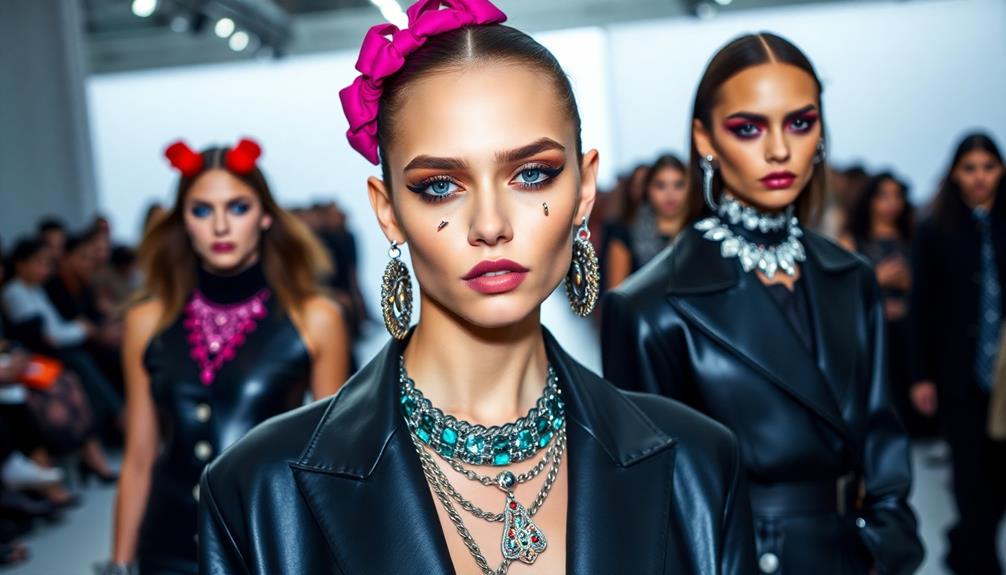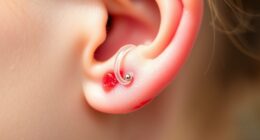Piercings can offer unique opportunities in the modeling industry, showcasing your individuality and helping you stand out in niche markets. However, mainstream modeling often prefers minimal piercings, typically just traditional ear ones. This means visibility can impact your marketability, especially in high-fashion roles. Freelance modeling allows more freedom to express your style, while alternative modeling agencies embrace diverse aesthetics. Your personal brand plays a crucial role too, so using social media effectively can help attract the right opportunities. Understanding the nuances of different agency preferences can enhance your chances for success. There's much more to uncover about this subject.
Key Takeaways
- Mainstream modeling typically favors minimal piercings, impacting marketability, especially in high-fashion roles.
- Alternative and niche modeling agencies embrace diverse styles, allowing for more expressive piercings and tattoos.
- Clear or flesh-colored retainers can help conceal visible piercings during professional shoots.
- Personal branding through social media can enhance visibility and attract opportunities that align with unique styles.
- Understanding agency preferences is crucial for effectively navigating modeling opportunities related to piercings.
Impact of Piercings on Careers

Piercings can notably impact your modeling career, shaping both opportunities and challenges. While they can enhance your unique look, potentially attracting job opportunities in niche markets like alternative fashion, they can also limit your options in mainstream modeling.
Many agencies prefer minimal piercings, often accepting only traditional ear piercings. If you have multiple or non-traditional piercings, you might need to remove them during auditions and shoots to align with agency preferences.
The visibility of your piercings can considerably affect your marketability, especially in high-fashion roles where agencies typically favor models without visible modifications.
If you're aiming for a more diverse portfolio, consider that freelance modeling offers more flexibility. This path allows you to express your individuality through piercings and tattoos, choosing brands that resonate with your style.
To maintain a professional appearance while keeping your body modifications, you can use clear or flesh-colored retainers during shoots. This strategy helps you conceal piercings, ensuring you meet industry standards while still expressing your personal flair.
Balancing your unique look with industry expectations is key to steering your modeling career successfully.
Agency Preferences and Trends

In the modeling world, agency preferences regarding piercings can greatly influence your career trajectory. If you're considering a modeling career, it's essential to understand the varying standards across different agencies. High-fashion agencies typically favor minimal piercings, often limiting you to traditional ear piercings. In contrast, alternative modeling agencies embrace a broader range of styles, welcoming models with unique piercings and tattoos.
| Agency Type | Piercing Preferences | Market Trends |
|---|---|---|
| High-Fashion | Minimal, often just ear piercings | Traditional looks dominate |
| Alternative Modeling | Diverse, edgy styles encouraged | Growing acceptance of individuality |
| Regional Agencies | Varies greatly by location | Trends shifting towards inclusivity |
| Avant-Garde | Bold, non-traditional accepted | Pushing boundaries of fashion norms |
Researching specific agency requirements is important. Some actively seek alternative models, expanding opportunities for those with piercings. While acceptance is growing, be prepared for the possibility of removing piercings for auditions or shoots, which can lead to concerns about closing up. Ultimately, understanding agency preferences can help you navigate your modeling journey effectively.
Personal Branding Strategies

A strong personal brand is your ticket to standing out in the competitive modeling industry. To achieve this, make sure you develop a unique style that reflects your personality and aesthetic. Showcase your versatility while staying true to your brand, whether you're a model even in niche markets or mainstream.
Consistently producing quality content can help solidify your topical authority within the modeling community.
Effective use of social media is vital; curate your online presence to enhance visibility and attract opportunities. Use platforms to highlight your individuality, especially if models have tattoos or piercings that set them apart. Consistency is key—align your portfolios, social media, and professional interactions to convey a cohesive image that resonates with agencies and clients.
Networking is another essential part of your personal branding strategies. Attend industry events and connect with other professionals in the modeling community to build relationships that can enhance your brand recognition.
Lastly, stay informed about current market trends and position your personal brand accordingly. By aligning your unique attributes with industry demands, you can secure your place in both mainstream and alternative modeling sectors.
Embrace these strategies, and you'll carve out your niche in the modeling world.
Experiences of Tattooed Models

Tattooed models are increasingly reshaping perceptions within the modeling industry, carving out distinct identities that challenge traditional beauty standards. You might notice that many of these models have successfully found niches, particularly in alternative and commercial modeling, where unique body art is celebrated. Models like Sarah Brannon and Faretta showcase their tattoos in high-profile campaigns, indicating a shift toward greater acceptance.
However, it's crucial to recognize that challenges remain, especially in high-fashion markets that often favor a more traditional aesthetic. Smaller, discreet tattoos generally have a better chance of being accepted in mainstream modeling, as they can be easily covered with makeup, allowing for greater versatility. The rise of social media has also empowered tattooed models to promote their distinctive styles and gain visibility.
Here's a look at some key aspects of experiences for tattooed models:
| Aspect | Description | Impact |
|---|---|---|
| Acceptance | Growing acceptance in niche markets | Increased opportunities |
| Challenges | High-fashion preference for tradition | Limited roles in high fashion |
| Visibility | Social media platforms | Enhanced personal branding |
| Body Art | Unique tattoos, piercings | Distinctive identity |
| Versatility | Discreet tattoos easily covered | Broader modeling options |
Navigating Niche Modeling Options

For models with body piercings, exploring niche modeling options opens up exciting avenues for self-expression and career growth. Niche modeling agencies often focus on unique looks, providing more opportunities than mainstream agencies. These agencies celebrate individuality, making them ideal for you if you want to showcase your body piercings and alternative style.
The rise of AI online jobs offers additional flexibility for models seeking opportunities that align with their aesthetic and personal brand.
Alternative modeling sectors embrace diverse aesthetics, allowing you to highlight your distinct look. By aligning with brands that appreciate body art, you can carve out a successful niche for yourself. Social media platforms have become invaluable tools for connecting with these brands, so use them to showcase your portfolio and attract like-minded companies.
Freelance modeling also offers flexibility, enabling you to approach brands that value your specific style and piercings. This path allows you to curate your career according to your preferences, focusing on collaborations that resonate with you.
However, it's essential to research and identify legitimate alternative modeling agencies. Finding the right fit can greatly expand your career opportunities and guarantee you're working within a supportive environment that celebrates your unique look.
Embrace the possibilities within niche modeling, and let your body piercings shine!
Frequently Asked Questions
Can You Have Piercings in Modeling?
Yes, you can have piercings in modeling, but it depends on the type and number. Many agencies prefer minimal body modifications, so you might need to remove or conceal certain piercings for specific jobs.
Why Don't Models Have Piercings?
Models often avoid piercings like a painter shuns distractions. They're expected to maintain a versatile, clean look that fits various styles, making it easier for clients to envision their brand without visible modifications.
What Are the Cons of Industrial Piercings?
Industrial piercings can lead to discomfort during healing, risk closing up if removed, and limit your opportunities in high-fashion modeling. Agencies often prefer minimal piercings, making it harder for you to secure desired roles.
Do Piercings Affect Job Prospects?
Imagine a chameleon, changing colors to fit in. Your piercings can shape how you're perceived. They might enhance your uniqueness but could also limit your job prospects, especially if the industry leans towards conventional appearances.
Conclusion
In the ever-evolving modeling industry, piercings can be your secret weapon or a potential hurdle. While agencies may have specific preferences, your personal brand can shine through if you navigate the landscape wisely. Embracing your unique style can open doors to niche opportunities you never dreamed possible. So, whether you're rocking a nose ring or a full sleeve, remember: authenticity is the ultimate trend that'll make you stand out like a diamond in a sea of pebbles.
















